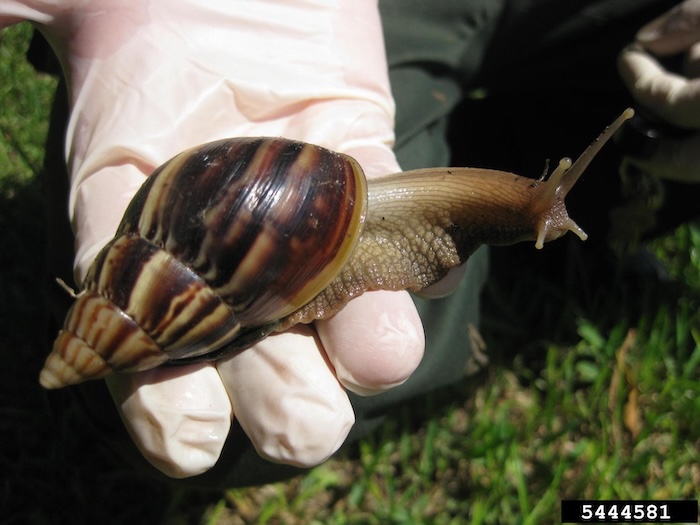Giant African snail
An exotic pest – not wanted in Australia
Giant African snail (Lissachatina fulica) is one of the world’s largest, most invasive and most damaging snails, capable of feeding on over 500 plant species, posing a serious risk to Australia’s horticultural indstries.
Keeping giant African snail it out of the country is a national priority.
Have you seen this pest?
- Adults are usually 50–100 mm but can grow up to 200 mm long and weigh 1 kg.
- Shells are generally light brown in colour with alternating brown and cream bands and faint yellowish vertical markings.
- Eggs are 4.5–5.5 mm in diameter, cream to yellow coloured and laid in batches of up to 400 eggs.



What should I do?
- Report it immediately.
- Share your photos with us using the online public reporting form or call the Exotic Plant Pest Hotline on 1800 084 881.
- Please take good-quality photos of the pest and/or damage to include in your report. For tips, see How to take good photos for a report.
Why is it a pest of concern?
The exotic giant African snail (Figure 1) is a ferocious eater of over 500 plant species. Most damage is caused to vegetable crops, flowers and ornamentals.
The snail can also spread bacteria, fungi and parasites to plants, animals and humans – such as ‘rat lung worm’, a nematode that can cause meningitis in humans. Do not pick up these snails without wearing gloves.
The snail is a nuisance in large numbers due to the stench from dead and rotting corpses.
Where to look
Giant African snails are active at night, spending their days hiding in leaf litter, piles of debris or other dark, damp places protected from the sun.
Snails can be seen travelling along fences and walls after dusk and sometimes on rainy, overcast days.
The snails can be found on machinery, motor vehicles and equipment, and as eggs in soil.
Pest profile
Appearance
- Adults: Large shells usually between 50mm and 100 mm long, but can be up to 200 mm and weigh up to 1 kg. The shell is long and conical-shaped, half as wide as long, generally light brown with alternating brown and cream bands and faint yellowish vertical markings on the upper ridges or whorls. Diet and environment influence shell colour variations. There is a golden variety with a yellow body and shell. Fully grown snails have 7 to 9 whorls on their shells (Figures 1 and 2).
- Immature (juveniles): Smaller versions of the adult but do not have all whorls developed.
- Eggs: Spherical to oval shaped and measure 4.5 mm to 5.5 mm in diameter. Colour ranges from cream to yellow (Figure 3).
Host plants in Australia
- Potential hosts range from Australian native and naturalised plants to agricultural crops across multiple ecosystems.
- Important economic crops including banana, bean, breadfruit, cabbage, cacao, carrot, cauliflower, cassava, cotton, cucumber, eggplant, marigold, melons, noni, okra, papaya, peas, pumpkin, sponge gourd, taro and ornamental plants.
Life cycle
- Giant African snails are hermaphroditic with both male and female organs, but reproduction cannot occur without a mate. Both partners in a mating pair will produce offspring.
- In ideal conditions eggs hatch 11 days after being laid, with snails becoming sexually mature after 6 months.
- Each snail can lay up to 1200 eggs in a lifetime.
- The lifespan is generally 3 to 5 years, but the snails can hibernate for years in drought conditions.
Distribution and dispersal
- Originally from the east coast of Africa, it has now spread to south and south-east Asia, Oceania, the USA and Canada.
- Giant African snails can hitchhike in shipping containers, crates, machinery and motor vehicles.
- Eggs are found in soil associated with imported goods.
Prevention
- Monitor imported cargo, host plants, soil and illegal importation as pets to prevent the introduction of the pest.
Image credits
- Figure 1: Giant African snail adult. Andrew Derksen, USDA-APHIS, bugwood.org (CC BY-NC 3.0 US).
- Figure 2: Giant African snails on papaya. Scot Nelson, Flickr 2011, public domain (CCO 1.0).
- Figure 3: Giant African snail eggs at the base of a papaya stem. Scot Nelson, Flickr 2011, public domain (CCO 1.0).
Reporting an unusual plant insect pest or disease
Report any unusual plant pest or disease immediately using our online reporting form or by calling the Exotic Plant Pest Hotline on 1800 084 881. Early reporting increases the chance of effective control and eradication.
Please take multiple good quality photos of the pests or damage to include in your report where possible, as this is essential for rapid pest and disease diagnosis and response.
Your report will be responded to by an experienced staff member, who may seek more information about the detection and explain next steps.
Report online